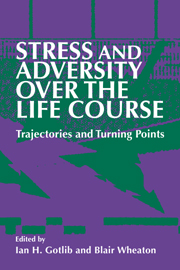Book contents
- Frontmatter
- Contents
- List of contributors
- 1 Trajectories and turning points over the life course: concepts and themes
- I Trajectories: long-term effects of adverse experience
- 2 Childhood adversity and adult psychopathology
- 3 The impact of twenty childhood and adult traumatic stressors on the risk of psychiatric disorder
- 4 Intergenerational sanction sequences and trajectories of street-crime amplification
- 5 School-leavers' self-esteem and unemployment: turning point or a station on a trajectory?
- 6 Intergenerational consequences of social stressors: effects of occupational and family conditions on young mothers and their children
- 7 Women's roles and resilience: trajectories of advantage or turning points?
- II Turning points: changes in life trajectories
- III New methods for the study of the life course
- Index
5 - School-leavers' self-esteem and unemployment: turning point or a station on a trajectory?
from I - Trajectories: long-term effects of adverse experience
Published online by Cambridge University Press: 23 October 2009
- Frontmatter
- Contents
- List of contributors
- 1 Trajectories and turning points over the life course: concepts and themes
- I Trajectories: long-term effects of adverse experience
- 2 Childhood adversity and adult psychopathology
- 3 The impact of twenty childhood and adult traumatic stressors on the risk of psychiatric disorder
- 4 Intergenerational sanction sequences and trajectories of street-crime amplification
- 5 School-leavers' self-esteem and unemployment: turning point or a station on a trajectory?
- 6 Intergenerational consequences of social stressors: effects of occupational and family conditions on young mothers and their children
- 7 Women's roles and resilience: trajectories of advantage or turning points?
- II Turning points: changes in life trajectories
- III New methods for the study of the life course
- Index
Summary
Background
Introduction
What happens to young people who leave high school, not for college but for the job market? Unemployment or underemployment may operate as a turning point in the way young adults view themselves, or it may culminate a life trajectory for which high school self-esteem serves as a marker. This chapter explores the relationship between employment status and psychological well-being in recent school-leavers in two ways. The first part reviews the literature on schoolleaver unemployment and psychological status and locates this work in the context of studies on adult unemployment. The second part presents some preliminary empirical findings from an ongoing study of the National Longitudinal Survey of Youth (NLSY).
Developmental and economic context. The transition to adulthood includes the adjustment from being a student in high school to being a college student or a worker and from living with parents to beginning the process of living on one's own and starting a family. Of these transitions, entering the work force may be especially formative (Mortimer & Borman 1988). For young people who go from high school to college and then graduate to high-status careers, this transition may be generally agreeable. Unfortunately, many young people drop out of high school, and three out of four high school seniors either do not go to college or do not complete college (Borman 1991).
School-leavers who enter the job market cannot begin their adjustment to work until they find a job, and many have difficulty doing this.
- Type
- Chapter
- Information
- Stress and Adversity over the Life CourseTrajectories and Turning Points, pp. 91 - 113Publisher: Cambridge University PressPrint publication year: 1997
- 3
- Cited by



